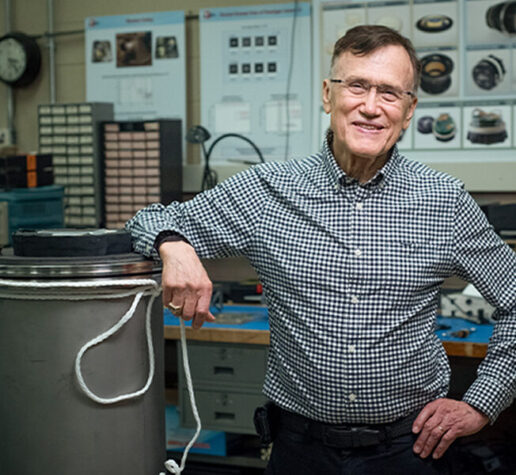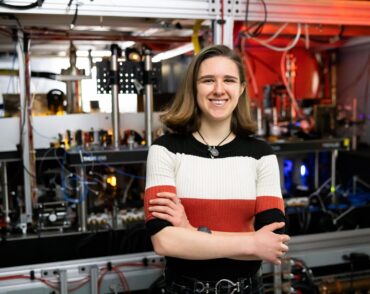
Planet hunting and the origins of life
George Ricker and his team at the MIT Kavli Institute are mapping the entire sky for signs of life.
George Ricker built his first telescope when he was in third grade. Growing up in rural Florida, with its abundance of dark night skies, facilitated his natural propensity for stargazing. But it was in Cambridge, Massachusetts, during his undergraduate days at the Institute that his fascination became a calling. “I was a physics major at MIT, but I took enough astronomy courses to decide that this was really what I wanted to do with the rest of my life,” says Ricker. He went on to earn an MS in astronomy from Yale University before completing his PhD work in the high-energy astrophysics group at the MIT Kavli Institute (MKI) for Astrophysics and Space Research, then known as the MIT Center for Space Research.
Degrees in pocket, Ricker returned to MKI as a research scientist. Then, as now, much of his research was devoted to developing solid-state photon detectors based on silicon charge-coupled devices (CCDs), resulting in his founding MKI’s CCD Laboratory in 1980. Among several noteworthy contributions to the field, he was the principal investigator on a project to develop the first photon-counting, imaging X-ray telescope ever flown in space, which was launched on a Japanese satellite in 1993. He and his group at the MKI CCD Lab would go on to build increasingly sophisticated and more sensitive detectors for other space missions, including NASA’s Chandra X-Ray Observatory, the world’s most powerful X-ray telescope, launched aboard the Space Shuttle Columbia in 1999.
Ricker also did influential work on small, inexpensive satellites for astronomical missions. He was, for example, the principal investigator for the international High Energy Transient Explorer (HETE-2) mission. Designed, constructed, and integrated at MKI, HETE-2 weighed just over 100 kilograms, and in the year 2000, it was launched into an equatorial orbit from the Marshall Islands in the western Pacific. It was the first satellite mission devoted to studying gamma-ray bursts (GRBs), and it established the locations and brightness of many of the first detectable short GRBs.
In recent years, Ricker and his team have garnered significant attention for their role in NASA’s Transiting Exoplanet Sky Survey (TESS) Explorer mission. With Ricker again serving as principal investigator, TESS is mapping the sky to discover planets outside our solar system. Since its launch in 2018, Ricker and his team have detected more than 6,000 planet candidates, including approximately 500 with their masses now established. “At this point, we’re discovering about a hundred candidate planets a month with TESS,” he says.
When Ricker and his group first conceived the idea for TESS around 2006, there were only a handful of known exoplanets. But Ricker had a hunch: “Given the small number of stars that had been searched for planets, we thought exoplanets were probably quite common, and we wanted to prove it.” At that point in time, NASA was planning to launch the Kepler space telescope, an exoplanet-hunting satellite designed to conduct a census of less than 1 percent of the sky. In contrast, Ricker and his colleagues at MKI wanted to build a satellite to survey the entire sky.
Using four special cameras developed in collaboration with MIT Lincoln Laboratory, they devised a method to capture widefield images — 5 percent of the sky at a time — and then to stitch the images together to provide a complete-sky view. “We basically step TESS around the sky taking exposures, and then put the images together, segment by segment, like slices from an orange,” Ricker explains. NASA recently approved TESS for an extended mission through 2025, and a further extension to 2028 is likely, according to Ricker. As the mission continues, the number of candidate exoplanets that Ricker and his team discover will increase by about 1,200 per year. Considering the mission’s depth and breadth, and the technological achievements that have made it possible, Ricker says with confidence, “We’re conducting a sky census in a unique way that has never before been possible.”
It took more than 6 million person-years to put the mission together, and according to Ricker, much of the work was accomplished through collaboration with industry. Industry partners helped develop special optical systems and integrated circuits for TESS, and many parts for the satellite were constructed by specialized manufacturing facilities. “One important thing that we’ve been able to do in our group at MKI is to interact closely with other talented small teams in the aerospace industry and at NASA,” he says.
With that in mind, Ricker believes the MIT Industrial Liaison Program (ILP) is a powerful force when it comes to connecting his cutting-edge research with real-world industry challenges. “MIT ILP’s role cannot be understated; it is essential to groups like mine at MKI that are developing specialized technologies,” he says. “Oftentimes we’re not completely familiar with industry wants and needs — ILP bridges that communication gap to foster meaningful connections capable of changing the world.”
Looking forward, Ricker and his lab are planning to utilize a spare flight camera built for TESS combined with a small telescope (about 45 centimeters in diameter), mounting both on another small satellite that would travel in a geosynchronous orbit. The satellite would work in tandem with TESS to provide greater sensitivity than TESS can alone, allowing them to identify short-duration events like supernovae and gravitational wave counterparts. It would also provide the opportunity to explore the outer solar system to better understand trans-Neptunian objects, leftover remnants from the solar system’s formation.
“One can ask, obviously, why we’re interested in these objects and outer space in general,” says Ricker. “There has been much speculation for many decades now about the possibility of finding habitable planets. The point, I believe, is to understand the formation and history of planets, thus helping us understand the origin of life and the future of our planet.”


